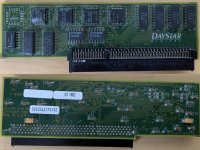Bolkonskij
Member
Hi everyone,
so, we have been using my beloved Mac IIci (dream machine of my youth; dad instead brought home a LC). I’ve heard the IIci does very well with a cache card installed. Unfortunately mine didn’t come with one.
I’ve seen ads of manufacturers claiming a 30-40% speed increase. Now we all know these ads (…). Anyone got a cache card in his IIci and would give me his/her hopelessly subjective opinion - is it worth the trouble finding a cache card? Is there really a noticeable speed gain? If so, is that gain application dependent or a general better performance?
I remember reading somewhere that the original Apple cache card from 1990 is to be avoided as it had a faulty chip that would lead to crashes. Right or is my memory serving me wrong? If so, which alternatives would you recommend?
Also, what’s the best place to find one of these cards today? I’m located in Germany. eBay turned up an Apple cache card in the U.S. and that is it. Any dealers that still sell that kind of stuff?
so, we have been using my beloved Mac IIci (dream machine of my youth; dad instead brought home a LC). I’ve heard the IIci does very well with a cache card installed. Unfortunately mine didn’t come with one.
I’ve seen ads of manufacturers claiming a 30-40% speed increase. Now we all know these ads (…). Anyone got a cache card in his IIci and would give me his/her hopelessly subjective opinion - is it worth the trouble finding a cache card? Is there really a noticeable speed gain? If so, is that gain application dependent or a general better performance?
I remember reading somewhere that the original Apple cache card from 1990 is to be avoided as it had a faulty chip that would lead to crashes. Right or is my memory serving me wrong? If so, which alternatives would you recommend?
Also, what’s the best place to find one of these cards today? I’m located in Germany. eBay turned up an Apple cache card in the U.S. and that is it. Any dealers that still sell that kind of stuff?
Last edited by a moderator:



